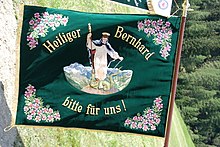Bernhard von Menthon

Bernhard von Menthon (also Bernhard von Aosta and Bernhard von Mont-Joux; * 983 or 1008 in Menthon-Saint-Bernard ; † June 15, 1081 or 1086 , according to some sources on May 28, 1007 in Novara ) is a saint of the Catholic Church and since 1923 patron saint of alpine residents and mountaineers. Bernhard von Menthon founded the hospice on the Great St. Bernhard , one of the first facilities for the purpose of rescue from mountain difficulties.
Life
Bernhard was a descendant of the noble Menthon family and related to the Burgundian Queen Ermengarde. He studied philosophy and law in Paris . His father, knight Richard von Menthon, intended to betroth him to a noble family. However, Bernhard did not want to obey this and fled to Aosta to see Archdeacon Peter. Bernhard was ordained a priest by him and was appointed his successor. Bernhard appeared as a traveling preacher in the Aosta Valley and the Diocese of Novara .
Bernhard von Menthon founded the hospice on the Great Saint Bernhard around 1050; some time later that on the Little St. Bernard too . The reason for this was that the alpine crossing of Mont-Joux between the Valais and the Aosta Valley was dangerous, but was still used by many travelers and also many pilgrims.
Bernhard tried in April 1081 in Pavia to prevent King Henry IV from fighting Pope Gregory VII . Heinrich wanted to depose Pope Gregory and in his place Clement III. bring to the throne. On the return journey from Pavia, Bernhard von Menthon died in Novara. His grave is in the local cathedral.
Bernhard also became famous for the rescue dogs named after him , the St. Bernard dogs . Even back then, the Augustinian Canons of the Great Saint Bernard used trained dogs as helpers and continued to breed them as an independent breed from the middle of the 17th century .
Afterlife
Bernhard von Menthon was venerated as a saint throughout Piedmont as early as the 12th century . In 1123 Bishop Richard of Novara declared him saint. Bernhard was officially canonized and included in the Roman martyrology in 1681 by Pope Innocent XI.
Pope Pius XI appointed Bernhard von Menthon in 1923 as patron of the Alpine inhabitants and mountaineers. To this end, on August 20, 1923, Pius issued an apostolic message to the Bishop of Annecy on the veneration of St. Bernard of Menthon:
“In order to increase the veneration of such a great man, which he has enjoyed uninterruptedly from the beginning until now, with the abundance of apostolic power, We want to declare St. Bernard of Menthon as the heavenly protector, not only for the Alpine inhabitants , but also for all those who pay homage to mountain sports. Truly, of all activities in which honorable relaxation is sought, none is more beneficial for mental and physical freshness than this, only daring must be avoided. If one climbs up after hard work and effort, where the air is thinner and cleaner, on the one hand the forces are renewed and strengthened, while on the other hand a person becomes more persistent even in the most difficult duties of life, because he bravely learns to face all dangers watch. When looking at the infinity and beauty of the magical images that open up, our soul rises slightly inspired to God, the author and lord of nature. "
The Tyrolean Mountain Rescue service locations occasionally display his picture on their club flags.
literature
- Gilbert Coutaz: Bernhard of Aosta. In: Historical Lexicon of Switzerland .
- Friedrich Wilhelm Bautz : Bernhard von Menthon. In: Biographisch-Bibliographisches Kirchenlexikon (BBKL). Volume 1, Bautz, Hamm 1975. 2nd, unchanged edition Hamm 1990, ISBN 3-88309-013-1 , Sp. 535.
Individual evidence
- ^ A b c Friedrich Wilhelm Bautz: Bernhard von Menthon. In: Biographisch-Bibliographisches Kirchenlexikon (BBKL). Volume 1, Bautz, Hamm 1975. 2nd, unchanged edition Hamm 1990, ISBN 3-88309-013-1 , Sp. 535.
- ↑ a b Bernhard von Menthon in the Saint Lexicon, accessed on September 9, 2017.
- ^ A b c Gilbert Coutaz: Bernhard of Aosta. In: Historical Lexicon of Switzerland .
Web links
| personal data | |
|---|---|
| SURNAME | Bernhard von Menthon |
| ALTERNATIVE NAMES | Bernhard of Aosta; Bernhard of Mont-Joux |
| BRIEF DESCRIPTION | Roman Catholic saint and patron saint of miners |
| DATE OF BIRTH | 983 or 1008 |
| PLACE OF BIRTH | Menthon-Saint-Bernard , France |
| DATE OF DEATH | May 28, 1007 or June 15, 1081 or June 15, 1086 |
| Place of death | Novara , Italy |
